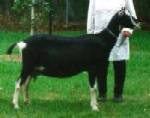 History
History
The British Alpine was developed in Great Britain from Sedgemere Faith, a doe found in the Paris Zoo in 1903. Although the British Alpine type existed prior to her discovery, she had great influence on the breed. The first type standard was drawn up in Britain in 1919 after sufficient true to type stock existed. The British Alpine was added to the British Goat Society herd book in 1926.
The first British Alpines were imported into Australia in 1958, although the breed was slow to establish itself due to the extremely limited gene pool. Crossbreeding with Saanens and Toggenburgs carrying a recessive black gene enabled the breed to be established. Some breeders worked with direct line breeding while others gradually upgraded using the recessive genes.
Later imports from the 1970s to the 1990s (some by embryo transplant) led to further improvements in the British Alpine Breed.
The British Alpine is very active and suited for a free ranging situation. They generally have high quality milk and are known for their extended lactations and ability to milk through winter.
Breed standard
GENERAL APPEARANCE (style & quality):Tall, rangy and graceful with smoothly blended body exhibiting pronounced triple dairy wedge shape, fine but not inclined to weakness. Does feminine, bucks obviously masculine in appearance.
HEAD (skull, eyes, ears, mouth, nostrils):Head long with strong square muzzle, facial line dished or straight, polled or neatly disbudded. Eyes set well apart, full and bright. Ears erect and pointing slightly forward. Side profile should show no tendency to undershot or overshot jaw
NECK:Blending smoothly into shoulders with or without tassels. Does long and fine. Bucks fine and strong not coarse.
BACKLINE:Back strong, straight and horizontal or rising slightly to hips.
FOREQUARTERS:Withers fine and high, blending firmly into shoulders. Chest full between the forelegs, deep in bucks, fairly deep in does.
BODY (barrel):Abdomen well rounded, large, deep and wedge shaped, of proportionate length.
HINDQUARTERS:Gradual slope from hips to tail, good width between hips and between thurls. Rump long and flat, pin bones wide and prominent.
LEGS (hooves):Long, strongly boned legs, but not coarse or heavy. Front legs straight and parallel from front and side. Hindlegs straight and parallel viewed from rear, hocks slightly bent when seen from the side. Pasterns fairly short and strong. Hooves sound and well-shaped.
UDDER:Back attachment high and broad, fore attachment carried well forward and blending smoothly to abdomen, not penduIous or unduly divided, showing good capacity. Skin colour dark pigmented in black and softly textured.
TEATS:Of adequate size for ease of milking, well attached and distinct from udder. Set well apart, pointing slightly forward and down, not outward.
TESTICLES:Scrotum well attached, relatively even and not divided or unduly penduIous, carrying two testes.
RUDIMENTARY TEATS:Two set wide apart slightly to the fore and side of the scrotum, of good size but not overdeveloped, unless the buck is milking.
SIZE (height):Does 83 cm (32.5 inches). Bucks 95 cm (37.5 inches).
COAT:Short, fine and glossy, may have fine grey undercoat. Bucks may have a longer coat.
COLOUR:Black with the following white Swiss markings – facial stripes from above eyes to muzzle and on muzzle, edges and tips of ears, legs from the knees and hocks down and insides of legs to trunk, on rump and under the base of tail. Facial stripes may fade in maturing bucks and may become grey on flanks with age.
DIFFERING FROM IDEAL (found and recognised):White ears, indistinct facial marks, white hair around cheeks, forehead, at the base of or on tassels, or on throat in place of tassels. Off white or cream markings instead of white. Colour tending to grey (salt and pepper) around base of ears, throat or under neck. Less intense black. Other than grey or black skinned udders. Horned. Nose with slightly raised bridge. Uneven tassels. Longer fringe along backline and hindquarters.
FAULTS:Rusty black coat colouring. Cow hocks. Steeply sloping rump. Dropped pasterns. Roach back or sway back. Size differing substantially from ideal. Uneven gait. Poor feet. Splayed feet. Low set ears. Weak or narrow chest. Shallow body. Lack of dairy quality. Fleshy penduIous or unduly divided udder. Pockets in udder. Teats: small, thin, large bulbous, ill-defined or unbalanced. Lack of milking capacity. Lack of masculinity in bucks. Divided, uneven or unduly pendulous scrotum. Spots on barrel smaller than a 10cent coin.
DISQUALIFICATIONS:Obviously undershot or overshot jaw (side profile). Wry face. Pink-skinned udder. Double teats, double orifices. Supernumerary teats. Intersex. Lack of Swiss markings. White or cream belly. Pendulous ears. Undescended testicles in bucks or one testicle only. Patches on barrel larger than a 10-cent coin.